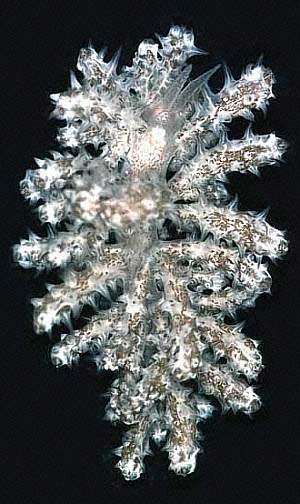Phyllodesmium spp from Okinawa
August 4, 1998
From: Bob Bolland

Note added 1 September 2008: This species, previously know as Phyllodesmium sp. 2 on the Forum, has recently been named Phyllodesmium koehleri. [see message #21853].
Dear Bill:
I have seven identified species of Phyllodesmium from here on Okinawa to date (Phyllodesmium briareum, crypticum, hyalinum, kabiranum, macphersonae, magnum, and poindimiei) and at least another twelve or so that I simply don't know. I'm enclosing a scan of what I believe to be yet another animal for the Okinawa species list, P. iriomotense (Baba, 1991), originally described from Iriomote Island, here within the Ryukyus Archipelago. I've collected three specimens from moderately deep water (two from 58m and one from 67m) while on SCUBA. All three of the animals were found apparently feeding on two separate species of octocorals, from which they were collected. The individual in the accompanying photo had a total living length of 44mm and was collected from 67m on 18 July, 1995.
I didn't wish to overload your resources with too many images so in addition to P. iriomotense, I'm only enclosing a single unknown for the time being. Phyllodesmium unk #1 was collected from 40m and had a total living length of 56mm; It was found crawling on top of strewn coral rubble and collected on 18 April, 1989. It's the only individual I've found here.
Photo: Unnamed species of Phyllodesmium (Bolland unknown sp #1), Okinawa, at 40m. It was found crawling on top of strewn coral rubble and collected on 18 April, 1989. PHOTO: Bob Bolland.
The sea slug forum continues to be a great service for getting opisthobranch information out over the Internet. Please keep up the terrific work.
Best regards,
bob
Bob Bolland
Okinawa
bolland@imicom.or.jp
Bolland, R.F., 1998 (Aug 4) Phyllodesmium spp from Okinawa. [Message in] Sea Slug Forum. Australian Museum, Sydney. Available from http://www.seaslugforum.net/find/187Dear Bob,
Thanks for the photos. Don't worry about overloading the system. I am happy to post anything you send. Concerning your unknown Phyllodesmium. I have it from New Caledonia and it is indeed unnamed and is one of a number I am planning to describe when they add a couple of extra days to each week.
To those unfamiliar with the genus, all species of Phyllodesmium feed on octocorals (alcyonarians, soft corals) and they have unique characters which seem to be associated with that lifestyle. Their radular teeth are quite distinctive and the cnidosac at the tip of each ceras, where defensive nematocysts are stored in most aeolids, has been replaced by a large gland which produces white sticky secretions. Also probably as a defensive strategy, species of Phyllodesmium can break off cerata when they are disturbed. The cerata covered in sticky secretions, wiggle and writhe around for some time after being cast off, which I presume is to distract predators from persevering with the rest of the animal.
Another interesting feature of at least some species of Phyllodesmium is their ability to remove zooxanthellae (single-celled plants) from their soft coral food and store them alive in their own bodies. The evidence suggests that some species of Phyllodesmium can utilise the sugars produced by these stolen plants for their own nutrition. Have a look at Solar powered nudibranchs for some more information on this.
Bill Rudman
Rudman, W.B., 1998 (Aug 4). Comment on Phyllodesmium spp from Okinawa by Bob Bolland. [Message in] Sea Slug Forum. Australian Museum, Sydney. Available from http://www.seaslugforum.net/find/187Related messages
-
Phyllodesmium koehleri on possible food
From: Erwin Koehler, September 8, 2008 -
Phyllodesmium koehleri from southern Queensland
From: Gary Cobb, September 1, 2008 -
Phyllodesmium koehleri from Sabah, Borneo
From: Richard Swann, September 1, 2008 -
Phyllodesmium koehleri from the Philippines
From: Erwin Koehler, September 1, 2008 -
Three new species of Phyllodesmium.
From: Bill Rudman, September 1, 2008 -
Phyllodesmium sp. 2 from Indonesia
From: Roberto Sozzani, February 27, 2004 -
Phyllodesmium sp 2 from New Britain
From: John & Debra Barrett, February 25, 2004 -
Phyllodesmium sp. on food
From: Atsushi Ono, May 30, 2000
